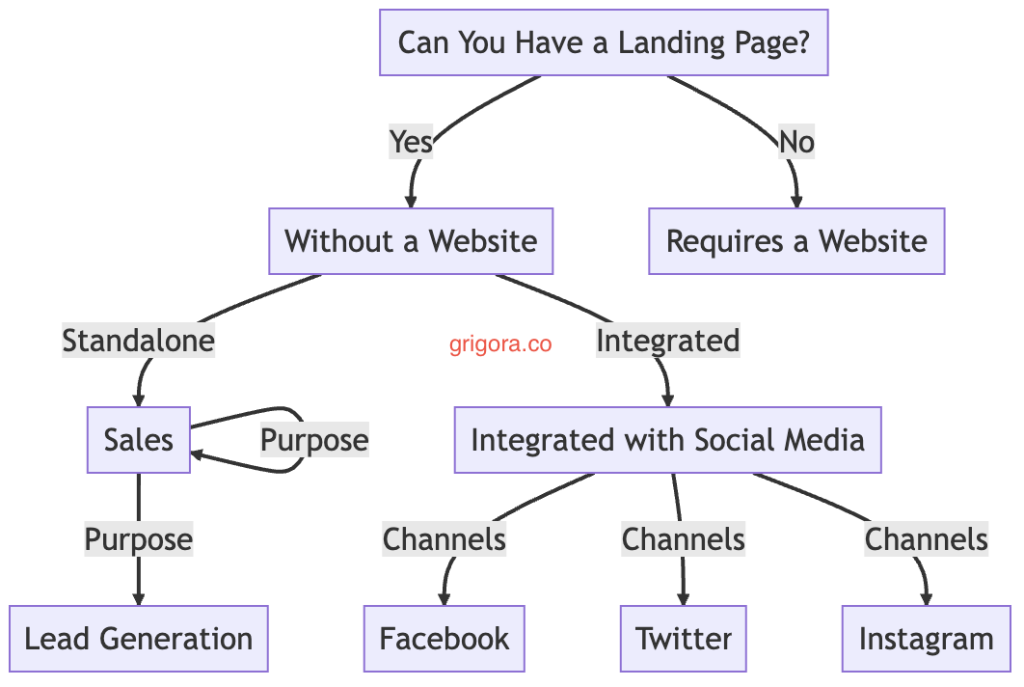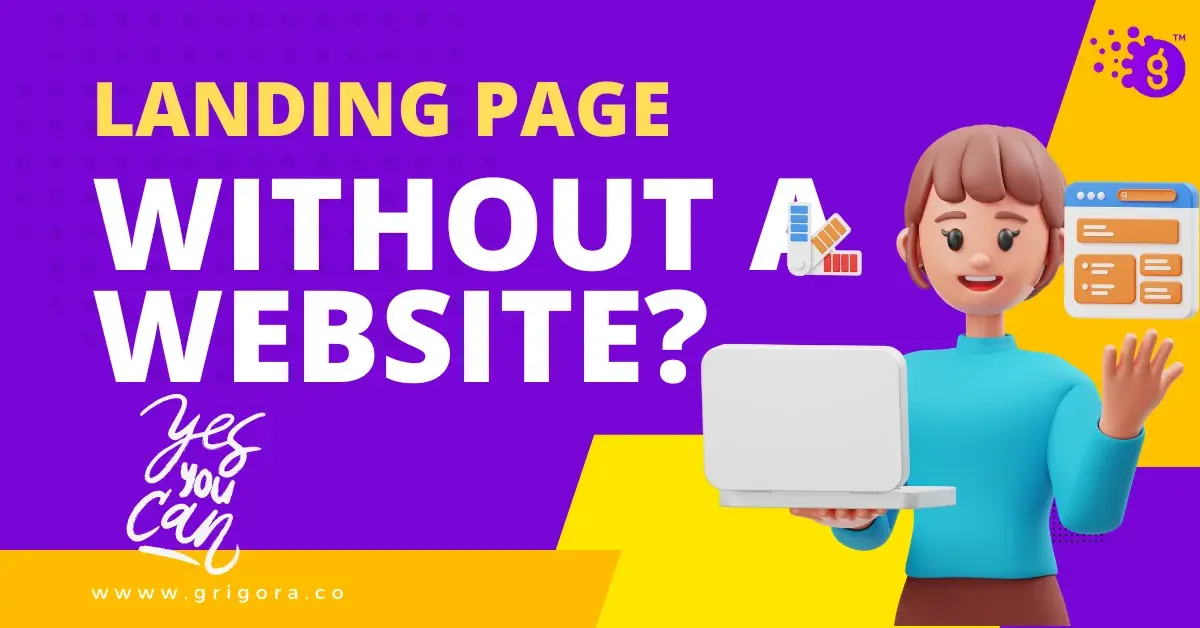Introduction
Let’s get something straight: landing pages and websites are not the same thing. A landing page is a single, focused page designed to convert visitors into leads. A website, however, is a collection of pages that provide a broader scope of information.
Yes, you can have a landing page without a full-fledged website. A standalone landing page can serve a specific purpose, such as capturing leads or promoting a single product, without the need for a complete website.
Purpose of This Article
So, you’re probably wondering, “Can I have a landing page without an entire website?” That’s exactly what we’re going to explore. Is it feasible? What are the pros and cons? Stick around to find out.
How Grigora Can Simplify Your Landing Page Creation
If the idea of creating a landing page sounds daunting, don’t worry. Grigora is here to make your life easier. With its user-friendly interface and customizable features, you can have a landing page up and running in no time, no full website needed.
By the end of this article, you’ll know whether a standalone landing page is the right move for your business and how Grigora can help you make it happen.
Understanding the Landing Page
A landing page serves a specific purpose: to guide visitors toward a particular action. Unlike general websites that offer various paths for a visitor to take, landing pages are designed with a single focus or goal, known as a call to action (or CTA, for short).
Core Elements of a Landing Page
Headline: The headline is the first component your visitors will see and should clearly indicate what your product or service is all about.
Call-to-Action (CTA): This is the key player. A strong CTA is essential for leading the visitor to take action.
Visuals: High-quality images or videos can help showcase your product or service and make your landing page more appealing.
Social Proof: Testimonials or reviews can add credibility and help to build trust with your audience.
Concise Copy: The content should be straightforward and to the point, providing essential information without overwhelming the visitor.
Primary Objectives: Conversions, Leads, Sales
Conversions: The ultimate goal is to convert visitors into customers, making the CTA a critical element.
Leads: Collecting email addresses or other contact information allows for future marketing opportunities.
Sales: For e-commerce landing pages, the objective is often immediate sales, making the layout and CTA placement crucial.
Understanding What Makes a Website
A website is a broader digital platform that serves multiple functions and caters to various user needs. Unlike a landing page, a website is a more complex structure with multiple pages, each serving a different purpose.
Basic Structure and Components
Homepage: This is the digital “front door” of your website. It’s often the first page visitors see and should provide a general overview of what your brand or business offers.
Navigation Menu: This is essential for guiding visitors through your website. It usually includes links to various sections like ‘About Us,’ ‘Services,’ ‘Blog,’ etc.
Content Pages: These are the meat of your website, where you go into detail about your products, services, or any other information you wish to convey.
Footer: This section often contains additional links, contact information, and sometimes a secondary navigation menu.
Long-term Goals: Branding, Information, Community
Branding: A website serves as a platform for establishing your brand identity through design, content, and user experience.
Information: One of the primary goals is to provide comprehensive information about your products, services, or mission.
Community: Websites often include forums, comment sections, or other interactive features to build a community around your brand or cause.
While landing pages are excellent for specific campaigns and objectives, a website is more like your online headquarters.
Exploring the Idea of a Standalone Landing Page

The concept of a standalone landing page is intriguing and, yes, entirely feasible. You don’t necessarily need a full-fledged website to have a landing page. Let’s delve into this a bit more.
Is it Technically Feasible?
Absolutely, it’s not only possible but also quite common in the digital marketing world. Standalone landing pages are designed for a specific purpose, such as capturing leads or promoting a particular product or campaign. They exist independently and are often disconnected from a website’s main navigation. This focused approach makes them highly effective for conversions.
Examples of Standalone Landing Pages
Product Launches: Companies often create standalone landing pages to introduce a new product or service, separate from their main website.
Event Promotions: These are used to provide information about an upcoming event and usually include a CTA for ticket purchase or registration.
Lead Generation: Businesses use these to collect user information, often in exchange for something valuable like an e-book or a free trial.
If you’re looking to create a high-converting standalone landing page without the hassle, Grigora offers easy-to-use templates and features that can get you up and running in no time.
| Criteria | Landing Page With a Website | Standalone Landing Page |
|---|---|---|
| Purpose | Multi-purpose, part of a larger online strategy | Single-purpose, focused on a specific objective |
| Cost | Generally higher due to website maintenance | Lower initial and maintenance costs |
| SEO Benefits | Higher, benefits from the website’s SEO | Limited, needs separate SEO efforts |
| Credibility | Enhanced by the website’s content and design | May require extra effort to establish trust |
| Content Scope | Can be extensive, part of larger content strategy | Focused and limited to the landing page’s objective |
| Speed of Launch | Slower, part of broader web development | Faster, can be set up quickly |
| User Experience | Integrated with the website’s overall UX | Tailored specifically for the landing page’s goal |
| Analytics | Part of broader website analytics | Focused analytics for specific campaigns |
| Flexibility | Less flexible due to website guidelines | Highly flexible, can be changed quickly |
| Long-term Strategy | Suited for long-term brand building | Often used for short-term campaigns or events |
| Platform Features (Grigora) | Comprehensive website and landing page features | Simplified, user-friendly landing page creation |
Advantages of Having a Landing Page Without a Website
The idea of having just a landing page, without an accompanying website, might seem unconventional, but it comes with a host of benefits. Let’s explore some of these advantages.
Quick to Launch
One of the most compelling reasons to go for a standalone landing page is the speed at which you can get it up and running. Unlike a full website, which can take weeks or even months to develop, a landing page can be launched in a matter of hours or days.
Cost-Effective
Building and maintaining a website can be expensive. However, a standalone landing page is usually much more budget-friendly. You can often use a simple drag-and-drop builder, reducing the need for a developer.
Focused on a Single Objective
The beauty of a landing page is its singular focus. Whether it’s to generate leads, promote an event, or launch a product, the absence of other distractions like site navigation ensures that your audience is directed towards that one specific action you want them to take.
Ideal for Event Promotions or Product Launches
If you have a one-off event or a specific product you’re promoting, a standalone landing page is perfect. It allows you to create a targeted marketing campaign without having to redesign or tweak your main website.
The Downsides: What You Might Miss
While standalone landing pages offer a range of benefits, they’re not without their drawbacks. It’s essential to weigh these cons carefully before making a decision.
Limited SEO Benefits
One significant downside is that a standalone landing page may not offer the same SEO benefits as a full-fledged website. With fewer pages to index and less content to rank, your landing page might not perform as well in search engine results.
Potential Credibility Issues
A standalone landing page without a supporting website could raise credibility questions among some visitors. They may wonder why there isn’t a full site, which could, in turn, affect their willingness to engage or convert.
Lack of Comprehensive Information
A landing page is designed to be concise and focused on a single objective. However, this brevity means you won’t be able to provide comprehensive information about your brand, products, or services, which could be a drawback for some visitors.
How to Create a Standalone Landing Page
Creating a standalone landing page can be a straightforward process, especially when you have the right tools and guidance. Here’s how to go about it:
Choosing the Right Platform: Grigora’s User-Friendly Features
The first step in creating a standalone landing page is selecting the right platform. Grigora offers a range of user-friendly features, including drag-and-drop editors and pre-designed templates, that make the process a breeze even for those without technical expertise.
Design Considerations
The design of your landing page should be visually appealing while also focusing on usability. Keep the layout clean, use high-quality images, and ensure that the color scheme aligns with your brand identity.
Content Essentials
Content is king, even on a landing page. Make sure to include essential information that will help visitors understand what you’re offering and why they should engage. Keep it concise but compelling.
Call-to-Action Elements
The call-to-action (CTA) is arguably the most crucial part of your landing page. It’s what prompts the visitor to take action, be it signing up for a newsletter or making a purchase. Make sure your CTA is clear, visible, and compelling.
Case Studies: Success Without a Full Website
Sometimes, seeing is believing. Let’s delve into some real-world examples that prove you don’t always need a full-fledged website to achieve online success.
Examples of Successful Standalone Landing Pages
There are numerous instances where standalone landing pages have outperformed traditional websites in terms of conversions and ROI.
Tesla’s Model S Reservation Page
Objective: To get reservations for the new Model S. Key Features: High-quality images, detailed specs, and a reservation CTA. Why It Worked: The landing page created a sense of luxury and urgency, encouraging users to reserve the new model.
Duolingo’s Course Signup Page
Objective: To get users to sign up for a language course. Key Features: Vibrant colors, engaging graphics, and a clear value proposition. Why It Worked: The page was visually appealing and clearly communicated the benefits of using Duolingo.
Airbnb Host Signup Page
Objective: To recruit new hosts for Airbnb properties. Key Features: Engaging visuals, simple form, and potential earnings calculator. Why It Worked: The landing page addressed the primary concerns of potential hosts and made the signup process appear simple.
Key Lessons and Best Practices
So, what can we learn from these success stories? First and foremost, focus is key. These landing pages were successful because they had a single, clear objective and were designed to guide visitors toward that goal. Additionally, they made excellent use of compelling visuals, persuasive copy, and strong CTAs.
By studying these examples and applying their best practices, you can maximize the potential of your own standalone landing page.
FAQs
You’ve got questions, we’ve got answers. Here are some of the most commonly asked questions about standalone landing pages.
Is a Standalone Landing Page a Good Long-term Strategy?
The answer to this question largely depends on your business goals. If you’re looking for quick conversions or promoting a specific event, a standalone landing page can be a fantastic short-term strategy. However, for long-term brand building and SEO benefits, you might want to consider developing a full website.
How Can I Optimize a Landing Page for SEO Without a Website?
While standalone landing pages may not offer the full SEO benefits of a comprehensive website, there are still ways to optimize them. You can focus on keyword-rich content, meta descriptions, and even consider running a PPC campaign to drive initial traffic.
What Are the Costs Involved?
The costs can vary depending on the complexity of the landing page and the platform you choose. However, standalone landing pages are generally more cost-effective than developing a full website.
How Can Grigora Enhance My Standalone Landing Page?
Grigora offers a range of user-friendly features that can take your landing page to the next level. From easy-to-use design templates to robust analytics tools, Grigora provides everything you need to create, launch, and monitor a successful standalone landing page.
Conclusion
Recap: The Feasibility and Practicality of Standalone Landing Pages
So, we’ve journeyed through the ins and outs of standalone landing pages, and guess what? They’re not just feasible; they can be incredibly practical too. Whether you’re launching a new product, promoting an event, or just need a quick, focused platform for conversions, a standalone landing page can be a powerful tool in your digital marketing arsenal.
Next Steps: How to Decide What’s Best for You
The ball is now in your court. Your next steps should be tailored to your unique business needs and objectives. If speed and focus are what you’re after, a standalone landing page might be your go-to. But if you’re looking at long-term brand building and a broader online presence, a full website could be more up your alley.
Either way, remember that tools like Grigora are here to simplify the process and empower you to make the best choice for your digital journey. So go ahead, weigh your options, and take that next big step. You’ve got this!



